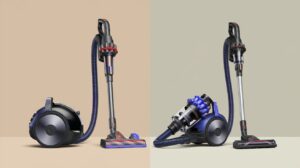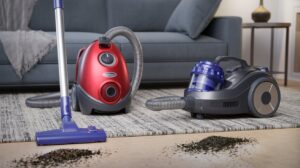Canister vs. Upright Vacuums: Which Is Better for Your Needs?
Keeping your home clean is essential for comfort and health. With so many vacuum cleaner options on the market, choosing the right one can be overwhelming. Two of the most popular types of vacuums are canister and upright models, each offering unique advantages.
This article explores canister vs. upright vacuums in detail, comparing features, benefits, and ideal use cases. By the end, you’ll have the information you need to make an informed choice.

What Are Canister Vacuums?
Canister vacuums consist of a motor and dust container unit connected to the cleaning head via a flexible hose. This design provides excellent flexibility, making them versatile for various cleaning tasks. They are particularly useful for homes with mixed flooring or hard-to-reach areas.
Key Features of Canister Vacuums
- Lightweight Hose and Wand: Canister vacuums allow for greater maneuverability in tight spaces, under furniture, and on stairs. The lightweight wand reduces strain during cleaning sessions.
- Versatile Attachments: These vacuums include tools for cleaning upholstery, curtains, corners, and hard floors. This makes them an all-purpose cleaning tool.
- Quieter Operation: With the motor housed in the canister, these vacuums operate more quietly than upright models.
Best Use Cases for Canister Vacuums
- Cleaning hardwood floors, tiles, and other hard surfaces
- Reaching tight corners, under furniture, and on stairs
- Vacuuming multi-level homes or spaces with varied flooring types
Canister vacuums are ideal for households where flexibility and adaptability are prioritized.
Introduction to Vacuum Types
Vacuum cleaners are essential for maintaining a clean and healthy home. Canister and upright vacuums dominate the market, each catering to specific cleaning needs. Canister vacuums are versatile and excel on hard floors and tight spaces. Upright vacuums, on the other hand, are powerful carpet cleaners and efficient in large areas.
Choosing between these two types depends on your household requirements and cleaning preferences. Canister vacuums provide quiet operation and adaptability, while upright models offer deep cleaning for carpets. Understanding the strengths and limitations of each will simplify your decision. This guide will help you find the perfect vacuum for your lifestyle. Whether you prioritize flexibility or power, you’ll discover which vacuum suits your home best.
What Are Upright Vacuums?
Upright vacuums are a popular choice for households with extensive carpeting and open spaces. They combine the motor, dust collection bin or bag, and cleaning head into one compact unit. This design allows for straightforward operation and efficient cleaning, making upright vacuums a favorite for many homeowners.
Key Features of Upright Vacuums
- Integrated Motorized Brushes: Upright vacuums typically include motorized brushes that agitate carpet fibers, lifting dirt and debris effectively. This feature makes them particularly adept at deep-cleaning carpets.
- Wide Cleaning Path: The cleaning head of upright vacuums is generally wider, allowing users to clean more surface area in a single pass. This feature is especially beneficial for larger rooms.
- Standing Design: These vacuums are designed to stand upright on their own, making them easy to store without requiring extra space or support.
Advantages of Upright Vacuums
- Carpet Cleaning Excellence: Upright vacuums excel in homes with wall-to-wall carpeting. Their strong suction and motorized brushes remove dirt, dust, and allergens effectively from deep within carpet fibers.
- Ease of Use: The all-in-one design of upright vacuums makes them simple to operate. There’s no need to pull a separate canister behind you while cleaning.
- Affordability: Upright vacuums often have a lower upfront cost compared to canister models, making them an accessible choice for budget-conscious buyers.
Drawbacks of Upright Vacuums
- Weight and Maneuverability: Upright vacuums are heavier than canister models, which can make them harder to maneuver, especially on stairs or in tight spaces.
- Noise Levels: These vacuums tend to be noisier, which might be a concern for households with pets, young children, or noise-sensitive individuals.
- Limited Versatility: While upright vacuums are excellent for carpets, they may struggle with hard floors, curtains, and tight corners without specialized attachments.
Best Use Cases for Upright Vacuums
- Large Carpeted Areas: Homes with extensive carpeting benefit most from the cleaning power of upright vacuums. The motorized brushes and wide cleaning path make them highly efficient.
- Open Floor Plans: Upright vacuums work well in spaces with minimal furniture, as their design makes them ideal for covering large, open areas.
- Quick Cleaning Sessions: For those who prefer a straightforward cleaning process, upright vacuums’ all-in-one design minimizes setup and effort.
Special Features to Look For
When shopping for an upright vacuum, look for features that enhance its performance and usability. Adjustable height settings allow the vacuum to transition between carpet and hard floors easily. Models with HEPA filters are a great choice for households with allergy sufferers, as they trap dust and allergens more effectively. Additionally, consider upright vacuums with detachable hoses or extra tools for added versatility.
Choosing the Right Upright Vacuum
Selecting the best upright vacuum involves evaluating your cleaning needs and preferences. If you have a home with high-pile carpets, opt for a model with strong suction and a motorized brush. For mixed flooring, consider an upright vacuum with adjustable settings and multiple attachments. Ultimately, the right vacuum should make cleaning efficient and tailored to your home’s specific requirements.
Upright vacuums remain a reliable and powerful choice for homeowners seeking efficient carpet cleaning and straightforward operation. While they may lack the flexibility of canister vacuums, their strength and simplicity make them a top choice for many households.
Comparing Canister and Upright Vacuums
When choosing between canister and upright vacuums, it’s important to compare their key attributes side by side. Understanding how they differ in terms of performance, ease of use, and versatility will help you make an informed decision.
Performance on Different Surfaces
Canister vacuums excel at cleaning hard floors, tiles, and low-pile rugs. Their lightweight wand and versatile attachments make them ideal for delicate surfaces and hard-to-reach areas. Upright vacuums, on the other hand, are designed for deep-cleaning carpets. Their motorized brushes and powerful suction penetrate thick carpet fibers to remove embedded dirt and debris effectively.
If your home features a mix of flooring types, a canister vacuum may be more adaptable. However, for homes with extensive carpeting, an upright vacuum is the better choice for consistent, thorough cleaning.
Ease of Maneuverability
Canister vacuums are easier to maneuver in tight spaces, thanks to their lightweight design and separate cleaning head. They glide smoothly under furniture, around corners, and on stairs. Upright vacuums are bulkier and less maneuverable, which can make cleaning stairs and tight spaces challenging.
That said, upright vacuums are more convenient for cleaning large, open areas. Their wider cleaning paths allow for faster cleaning, making them a time-saving option for spacious rooms.
Noise Levels
One of the standout features of canister vacuums is their quieter operation. The motor is housed in a separate unit, reducing the noise level during use. This makes them a great choice for households with pets, young children, or individuals sensitive to noise.
Upright vacuums tend to be louder due to their compact design, where the motor is located closer to the cleaning head. If noise is a concern, a canister vacuum might be the more suitable option.
Storage and Portability
Upright vacuums are easier to store, as they stand upright without needing additional support. Canister vacuums, with their separate components, often require more storage space. However, canister models are typically lighter, making them easier to carry between rooms or up and down stairs.
Maintenance and Durability
Both canister and upright vacuums require regular maintenance to ensure optimal performance. Canister vacuums often have detachable components, making them easier to clean and maintain. Upright vacuums, while simpler in design, may require more frequent maintenance due to their integrated motorized brushes.
In terms of durability, both types are built to last when cared for properly. Choosing a reliable brand with high-quality materials is essential for long-term use.
Cost Considerations
Canister vacuums are generally more expensive upfront, but their versatility and longevity can make them a worthwhile investment. Upright vacuums, while more affordable, may require additional purchases for specialized attachments or filters.
Ultimately, the choice between a canister and an upright vacuum depends on your specific needs. Consider factors such as your home’s layout, flooring types, and cleaning habits. By weighing the pros and cons of each type, you can make a choice that aligns with your cleaning preferences and household demands.

Pros and Cons of Each Vacuum Type
Understanding the pros and cons of canister and upright vacuums can help you identify the best option for your needs. Each type offers distinct advantages and potential drawbacks, which are essential to consider during your decision-making process.
Canister Vacuum Pros
- Versatility: Canister vacuums are designed to handle a variety of cleaning tasks. They excel at cleaning hard floors, carpets, curtains, and upholstery with their wide range of attachments.
- Quiet Operation: Canister models operate more quietly than upright vacuums, making them ideal for households with noise sensitivity.
- Maneuverability: The lightweight design of the cleaning wand and hose allows canister vacuums to reach under furniture, around corners, and up stairs easily.
- Efficient Storage: Despite requiring more space, their detachable components make them compact for specific storage setups.
Canister Vacuum Cons
- Higher Cost: Canister vacuums tend to have a higher upfront price compared to upright models.
- Bulkier Design: The separate canister unit can be cumbersome to move around, especially in smaller spaces.
- Complex Assembly: Canister vacuums may require more setup before use, with multiple attachments and parts to manage.
Upright Vacuum Pros
- Powerful Carpet Cleaning: Upright vacuums excel at deep-cleaning carpets, with motorized brushes designed to agitate fibers and extract dirt.
- Ease of Use: Their all-in-one design simplifies operation, making them user-friendly for quick cleaning tasks.
- Affordable Options: Upright vacuums are often more budget-friendly, offering high performance at lower price points.
- Compact Storage: The upright design allows for easy storage without needing additional support.
Upright Vacuum Cons
- Heavier Build: Upright vacuums are bulkier and heavier, which can make maneuvering around tight spaces or up stairs challenging.
- Limited Versatility: These vacuums may require additional attachments for cleaning curtains, upholstery, and hard floors effectively.
- Higher Noise Levels: Upright models are generally noisier than canister vacuums, which may be a drawback for noise-sensitive users.
By weighing these pros and cons, you can determine which vacuum aligns with your priorities. If you need a quiet, versatile vacuum for mixed flooring, a canister model is ideal. Conversely, if you prioritize powerful carpet cleaning and ease of use, an upright vacuum is the better choice.
Choosing the Best Vacuum for Your Needs
Selecting the perfect vacuum cleaner requires assessing your home’s layout, flooring types, and cleaning preferences. Start by identifying the most important factors for your household, such as noise levels, storage space, and cleaning versatility.
For Carpeted Homes
If your home features extensive carpeting, an upright vacuum is the clear choice. Look for models with strong suction and motorized brushes that effectively lift dirt and debris from deep within carpet fibers. Consider additional features like height adjustment for transitioning between different carpet piles and hard floors.
For Mixed Flooring
Homes with a combination of carpets, hardwood, and tile floors will benefit from the adaptability of a canister vacuum. With its versatile attachments and lightweight wand, a canister model can seamlessly transition between surfaces. Opt for a vacuum with a hard floor attachment to prevent scratches and maintain the integrity of your flooring.
For Small Spaces and Stairs
Canister vacuums excel in compact spaces and homes with stairs. Their lightweight design and maneuverable cleaning head make them ideal for reaching tight corners and cleaning multiple levels. Look for a model with a long power cord or retractable cord for added convenience.
For Allergy Sufferers
If allergies are a concern, prioritize vacuums with HEPA filters that trap allergens and fine dust particles. Both canister and upright vacuums offer models with HEPA filtration, but canister vacuums may have the edge in reducing airborne allergens due to their sealed systems.
For Budget-Conscious Buyers
Upright vacuums are generally more affordable, making them a great option for budget-conscious buyers. However, investing in a higher-quality canister vacuum may save you money in the long run due to its durability and performance.
Additional Considerations
- Bagged vs. Bagless: Decide whether you prefer a bagged vacuum for reduced dust exposure during disposal or a bagless model for convenience.
- Corded vs. Cordless: Cordless vacuums offer greater flexibility, while corded models provide consistent power for longer cleaning sessions. Evaluate your cleaning habits and the size of your home to determine which option suits you best.
- Weight and Portability: If carrying the vacuum between floors is a frequent task, prioritize lightweight models with ergonomic handles for easier transport.
- Warranty and Maintenance: Check for warranties and customer support options. A reliable brand with good customer service can make maintenance and repairs much easier over the vacuum’s lifespan.
- Noise Levels: For households with pets or children, or if you prefer a quieter cleaning experience, consider vacuums known for their reduced noise output, such as certain canister models. By carefully evaluating these factors, you can choose a vacuum cleaner tailored to your specific needs. Whether you decide on a canister or upright vacuum, selecting the right model will ensure your home stays clean, comfortable, and inviting.

Conclusion: Canister vs. Upright – The Final Verdict
Both canister and upright vacuums have their unique strengths and drawbacks. Your choice ultimately depends on your home’s layout, flooring types, and cleaning preferences.
Choose a canister vacuum if you:
- Have mixed flooring or hard surfaces.
- Need quiet operation and versatility.
- Require a lightweight and maneuverable vacuum for tight spaces or stairs.
Opt for an upright vacuum if you:
- Have extensive carpeting and need deep cleaning.
- Prefer a straightforward, all-in-one design.
- Want a more budget-friendly option.
Investing in a vacuum that aligns with your cleaning needs ensures not only a cleaner home but also a more enjoyable cleaning experience. Take the time to evaluate your priorities and make an informed choice for the best results.